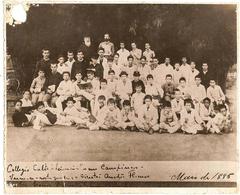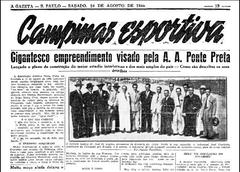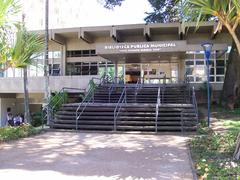
Sobrado à Rua Doutor Salles de Oliveira, Campinas, Brazil: Visiting Hours, Tickets, and Historical Site Guide
Date: 04/07/2025
Introduction
The Sobrado à Rua Doutor Salles de Oliveira, located in Campinas, São Paulo, stands as a living testament to the city’s urban evolution, architectural elegance, and vibrant multicultural heritage. Built during the city’s coffee boom and industrial expansion, this two-story townhouse is a prime example of the sobrado architectural style, blending commercial and residential uses with ornate facades and traditional masonry. Today, the sobrado not only preserves a vital piece of Campinas’s history, but also serves as a hub for cultural events and guided tours, offering visitors an immersive journey into the city’s past and present (Audiala; Wikipedia).
Table of Contents
- Early Development of Campinas and Sobrado Architecture
- Historical Context: Vila Industrial and Rua Doutor Salles de Oliveira
- Architectural Features and Preservation Efforts
- Socioeconomic and Cultural Significance
- Historical Events and Community Role
- Practical Visitor Information
- Nearby Attractions and Suggested Itineraries
- Urban Evolution and Modern-Day Relevance
- Preservation Challenges and Future Prospects
- Frequently Asked Questions (FAQ)
- Conclusion: Why Visit the Sobrado?
- References and Further Reading
Early Development of Campinas and Sobrado Architecture
Founded in 1774, Campinas transformed from a Bandeirantes outpost to a dynamic urban center, spurred by the 19th-century coffee and sugarcane booms (audiala.com). The economic prosperity of this era led to the proliferation of sobrados—distinctive two-story buildings with commercial space below and residential quarters above. These structures, featuring masonry construction, high ceilings, and ornate facades, symbolized social mobility and urban sophistication (brol.com).
Historical Context: Vila Industrial and Rua Doutor Salles de Oliveira
Vila Industrial, where the sobrado is located, emerged as a hub for factory workers, artisans, and entrepreneurs during Campinas’s industrial expansion in the late 19th and early 20th centuries (ruacep.com.br). The neighborhood’s proximity to railway lines and industry fostered a unique blend of residential and commercial life. Sobrados along Rua Doutor Salles de Oliveira became landmarks of this transformation, reflecting the aspirations and diversity of their residents (Informações do Brasil).
Architectural Features and Preservation Efforts
The sobrado at Rua Doutor Salles de Oliveira exemplifies the era’s architectural details:
- Facade: Symmetrical design, decorative stucco moldings, wrought-iron balconies, and tall shuttered windows.
- Layout: Ground floor for commercial use; upper floor for residential living, accessed by an internal staircase.
- Materials: Brick masonry, lime-based stucco, timber floors, and ceramic roof tiles.
- Interiors: High ceilings, wooden staircases with balustrades, and partitioned rooms around central corridors.
Since being listed by CONDEPHAAT in 2015, the sobrado’s features are protected, ensuring ongoing restoration and preservation (Wikipedia; ExploreCity.life).
Socioeconomic and Cultural Significance
The sobrado is more than an architectural gem—it encapsulates Campinas’s social and economic shifts during the coffee boom and railway era. These buildings housed generations of immigrant families from Italy, Portugal, and Africa, fostering a multicultural community and serving as meeting places for labor and social movements (ExploreCity.life). The sobrado’s location, near major transport routes, underscores its role in commerce and community life.
Historical Events and Community Role
While direct records of this sobrado’s residents are limited, Vila Industrial was a center for labor activism and political engagement in early 20th-century Campinas. Sobrados like this one often hosted union meetings and community gatherings, contributing to the city’s history of social change (ExploreCity.life). The area also produced notable figures such as composer Carlos Gomes and President Campos Salles, reflecting its cultural vibrancy (audiala.com).
Practical Visitor Information
Visiting Hours and Tickets
- Open: Tuesday to Sunday, 9:00 AM – 5:00 PM
- Closed: Mondays and public holidays
- Admission: Free; donations are welcome to support preservation efforts
- Guided Tours: Available on weekends at 10:00 AM and 3:00 PM; reserve via the Campinas cultural heritage website
Accessibility
- Ground Floor: Wheelchair accessible; assistance available upon request
- Upper Floors: Limited access due to stairs, but guides can accommodate visitors with mobility challenges
Special Events
The sobrado regularly hosts exhibitions, cultural events, and workshops. Check the official Campinas tourism website for current programming.
Travel Tips
- Best Time to Visit: Weekday mornings for a quieter experience
- Photography: Permitted in public areas; ask staff during tours
- What to Bring: Comfortable shoes for exploring the neighborhood, and a camera to capture the sobrado’s detailed ornamentation
Nearby Attractions and Suggested Itineraries
Explore more of Campinas by visiting these sites within easy reach of the sobrado:
- Estação Cultura: A former railway station turned cultural center featuring exhibitions and community events (Wanderlog).
- Mercado Municipal: Historic market with local foods and crafts (Campinas Virtual).
- Metropolitan Cathedral: One of the largest rammed-earth structures in Latin America.
- Parque Portugal (Lagoa do Taquaral): Urban park with a lagoon, planetarium, and family attractions.
Sample Itinerary:
- Morning: Tour the sobrado and Vila Industrial
- Lunch: Mercado Municipal
- Afternoon: Estação Cultura and Parque Portugal
Urban Evolution and Modern-Day Relevance
Many sobrados on Rua Doutor Salles de Oliveira have found new life as cultural centers, galleries, or businesses, preserving their historical integrity while adapting to contemporary needs (triplyzer.com). Municipal initiatives and educational programs have made these sites focal points for heritage tourism and community engagement (ExploreCity.life).
Preservation Challenges and Future Prospects
The sobrado faces challenges from urban development and maintenance costs. Community advocacy and municipal support are essential for its continued preservation, ensuring that future generations can experience this link to Campinas’s past (ExploreCity.life).
Frequently Asked Questions (FAQ)
Q: What are the visiting hours of the Sobrado à Rua Doutor Salles de Oliveira?
A: Open Tuesday to Sunday, 9:00 AM – 5:00 PM.
Q: Is there an entrance fee?
A: Entry is free, but donations are appreciated.
Q: Are guided tours available?
A: Yes, on weekends at 10:00 AM and 3:00 PM; booking is recommended.
Q: Is the sobrado wheelchair accessible?
A: The ground floor is accessible; upper floors may be limited due to stairs.
Q: Can I take photos inside?
A: Photography is allowed in most areas; check with staff during tours.
Conclusion: Why Visit the Sobrado?
The Sobrado à Rua Doutor Salles de Oliveira offers a unique window into Campinas’s architectural, social, and cultural evolution. Its preserved features, engaging tours, and central location in Vila Industrial make it an ideal starting point for discovering the city’s history. Whether you’re drawn by its beautiful facade, rich stories, or community atmosphere, a visit to this sobrado is both inspiring and rewarding.
References and Further Reading
- Audiala
- Wikipedia
- Informações do Brasil
- Lopes Imóveis
- São Paulo Secreto
- Campinas Virtual
- Wikivoyage
- ExploreCity.life
- Wanderlog
- triplyzer.com
For up-to-date information on events and tours, download the Audiala mobile app or consult official Campinas tourism portals. Begin your exploration of Campinas’s remarkable heritage today!






